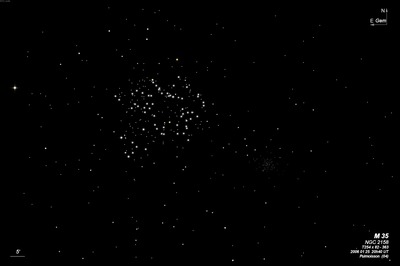
Phillippe De Chéseaux discovered M35 = NGC 2168 = h377 in 1745-46. John Bevis independently found the cluster before 1750 (possibly earlier than De Chéseaux). On 19 Feb 1827 (sweep 58) John Herschel described "a L, coarse, p rich cl of st 9...16m, which fills 2 or 3 fields, but cheifly one in which are about 100 stars."
200/250mm - 8" very bright string cluster, very large, excellent field but not rich in faint stars. Many of the stars are arrange in rows and loops.
400/500mm - 18" (11/14/09): gorgeous view at 75x, which beautifully frames the cluster as well as nearby NGC 2158. The densest portion is the central 25' where roughly 250-300 stars are resolved. The cluster is noticeably lopsided due to a loop of stars that juts out on the SE side of the cluster. This loop includes mag 7.5 HD 42086 near its SE end. The brightest cluster star is a double on the north side (O∑ 134 = 7.5/9.1 at 31") with a bright orange-colored primary. A prominent loop of stars heads south and curves to the west beginning at O∑ 134. This same chain nearly merges with another prominent chain of fainter stars that begins on the west side of the cluster and forms a string that heads east through the cluster. Other loops and chains caught my eye as star chains seem to outline regions where there are star voids. The cluster itself resides in a rich star field though is fairly well-detached by a region of lower star density surrounding the cluster, particularly around the south side.
Naked-eye - Visible as a fairly small naked-eye glow in a dark sky.
Notes by Steve Gottlieb